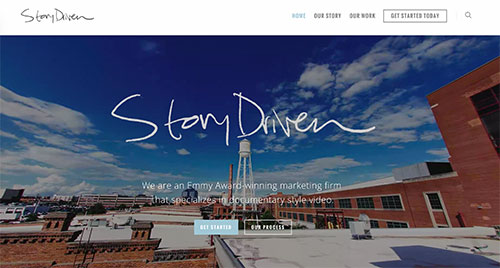Videos can be very effective for marketing, but they aren’t cheap to make. And low quality videos have poor return on investment. Research by the Content Marketing Institute looked at 200,000 YouTube business videos and discovered that more than 50% of them had less than 1,000 views.
Many videos created by businesses and other organizations are boring, poorly made, or just blah. When investing in video, you should aim for high-quality results that support your marketing objectives.
So how do you create the best video possible for your money?
The key to creating a terrific video and having a great relationship with your video team is to get everyone the same page - and keep them there. So says the experienced team at StoryDriven, a marketing firm with a specialty in documentary-style video located in Durham, NC. The group has made videos for organizations such as Harvard Business School, CrossComm, Durham Academy, North Carolina State University, and the University of North Carolina.
 I sat down with Nathan and Bryce of StoryDriven to understand how we can do a better job of working with videographers, keep on the same page, and end up with impactful videos. Learn from them in our interview below:
I sat down with Nathan and Bryce of StoryDriven to understand how we can do a better job of working with videographers, keep on the same page, and end up with impactful videos. Learn from them in our interview below:
What are your goals as videographers?
Bryce: We want to make sure that we are communicating the message that truly needs to be communicated. We need to take time to understand what the client is trying to say and get all the important information before we start shooting. Success often depends on the pre-production work - figuring out the right structure of the story, doing pre-interviews, and so on - you should have a clear idea of how the video should be laid out before you start producing it. This makes for an enjoyable experience.
Nathan: Also we want to be a strategic content partner that goes beyond video. For example, we can take your video and transcribe it and then you have tweets for days or weeks. We can pull still frames with quotes overlaid for easy social media posts. We want to see that your video has maximum impact, so you can reach your business goal and feel you got the most of your investment.
What things do clients do that annoy you?
Nathan: It's frustrating when we get called in, and the client has already decided on all the things that make a story good or bad. If we don’t have the chance to give input and bring our expertise as storytellers through video, we are limited from the get-go. Some clients would rather have their video vendor execute than be a collaborative partner. And we’ve realized that videographers start to expect this. But we help our clients get more out of their video when we develop ideas together. We’ve seen what works and doesn’t over many years and types of videos.
Bryce: Good communication is key to any healthy relationship. Part of that communication is aligning expectations. Assumptions about responsibilities and workload is a formula for disaster. Our job is to educate our clients and be their guide throughout the process. Take workload for example, oftentimes clients don’t realize that even a small change to a video will require us export, compress, upload and deliver it again - changes should be sent in batches so the process isn’t bogged down with a continuous stream of minor tweaks.
What do you wish clients did more of?
Nathan: Provide positive feedback along with negative feedback - that’s always nice, we are human beings too.
Bryce: Patience is important. If someone were to come to us saying, "We need this next week," that’s just not realistic for success. Video needs to be incorporated into your strategic communications plan. Give your video partner a three month window.
How much do high quality videos cost?
Nathan: It depends on the complexity of the story being told and the length of the video. It’s actually harder to make a shorter video than a longer one. There is a wide range in the industry, but the best videographers in our area might price a video with three characters anywhere from $15,000 to $50,000.
Bryce: It's always going to cost more than you think it is. If you are deciding who to use based on a bid war, you might luck out and find someone early in their career who charges less. But, you want to make sure that you are working with someone who “gets it,” wants to understand who you are and where you are coming from, and can expand upon your brand. Keep in mind that big equipment does not equal value. Value is understanding and being able to collaborate with a trusted partner.
Do you have any other advice for those hiring videographers?
Nathan: Always give your video person a deadline even if it's arbitrary. This helps us prioritize our other work and get it to you in a reasonable time. And be sure there is one contact person for us who can consolidate feedback so we aren’t getting different direction from various team members.
Bryce: If you work with someone to build a relationship, every time you do a project together it's going to get better since both parties come in with more knowledge and understanding of the situation. We love what we do and think that not only can we produce terrific videos, but the process itself can be fun for all.
Nathan: Yes, we love what we do and especially like finding partners to work with for the long-term. View your video team as a relationship, treat them like you like to be treated, and you are going to get more exciting video and care on your projects.
Thank you, StoryDriven team!
Check out some recent work by StoryDriven:
Investors' Circle - The Investor Story from StoryDriven on Vimeo.
If you have any further questions on documentary style video, you can reach out to the StoryDriven team or contact me for advice.

 I sat down with Nathan and Bryce of StoryDriven to understand how we can do a better job of working with videographers, keep on the same page, and end up with impactful videos. Learn from them in our interview below:
I sat down with Nathan and Bryce of StoryDriven to understand how we can do a better job of working with videographers, keep on the same page, and end up with impactful videos. Learn from them in our interview below:
 As much as I dislike the cold weather, when snow falls, we all slow down here in the South — and that I secretly love.
We have to pause because most of us don’t have experience driving in snow, and our area isn’t well prepared for “wintry mix” or serious snowstorms. There’s usually a flurry of activity at the grocery store in the 24 hours before a storm, but then a hush falls over the town I live in.
As much as I dislike the cold weather, when snow falls, we all slow down here in the South — and that I secretly love.
We have to pause because most of us don’t have experience driving in snow, and our area isn’t well prepared for “wintry mix” or serious snowstorms. There’s usually a flurry of activity at the grocery store in the 24 hours before a storm, but then a hush falls over the town I live in.